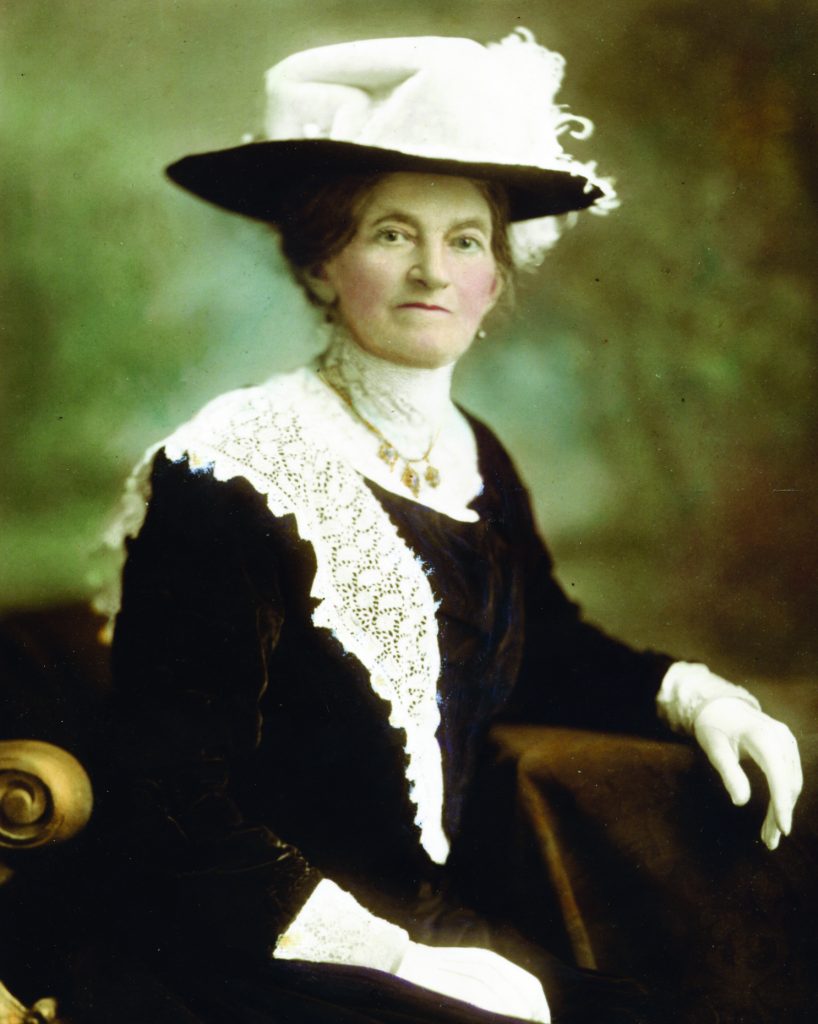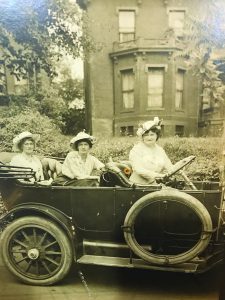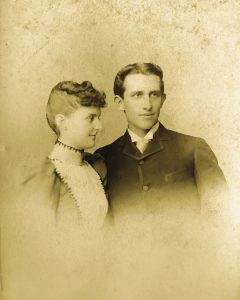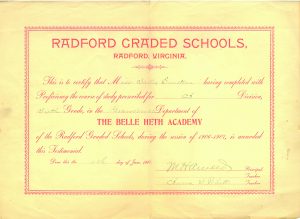
Belle Heth. Photo Courtesy of Anne Heth Connor.
When referring to their Elementary School, many teachers, parents, and children in Radford speak the words ‘Belle Heth’ every day. Few realize, however, that Belle Heth was also an extraordinary person. So notable, in fact, that the school located at 151 George Street has born her name for nearly one-hundred and forty years. Belle Heth was a lifelong resident of what is now Radford, and it was she who gifted a town lot for the purpose of building a new school. The school became the Belle Heth Academy, but Belle’s role in Radford’s history goes far beyond those halls.
In 1842, Belle Heth was born Isabella Norwood Hammet to parents Edward and Clementina Craig Hammet. At the time, the Hammets were a prosperous, slaveholding family living at their 500-acre estate called Norwood. Belle’s father had emigrated from Ireland in 1825 and by the 1830’s had established himself as a prominent citizen. Edward was an influential man. He also started the Presbyterian church in Radford, now known as Old Brick Presbyterian Church. In the 1850’s, he championed the development of a rail line through the region, and it was fifteen acres of his own land that first became known as Central Depot. It was this critical piece of development that gave rise to the City of Radford.
 It was Belle’s birth into this affluent and influential family that enabled her to receive an education during a time when higher learning was strictly a luxury. She received her diploma in 1860 from the Virginia Female Institute in Staunton, Virginia. She was an intelligent person, and it is evident from family documents that her family placed great faith in her abilities. She and her sister, Sue, along with their brothers, participated in multiple aspects of the operation of the family’s estate. This experience would serve Belle very well in years to come.
It was Belle’s birth into this affluent and influential family that enabled her to receive an education during a time when higher learning was strictly a luxury. She received her diploma in 1860 from the Virginia Female Institute in Staunton, Virginia. She was an intelligent person, and it is evident from family documents that her family placed great faith in her abilities. She and her sister, Sue, along with their brothers, participated in multiple aspects of the operation of the family’s estate. This experience would serve Belle very well in years to come.
(Left: Belle Heth, Pickett Heth and Virginia Heth in front of their home in Washington, D.C. Photo Courtesy of Sue Heth Bell.)
In 1867, Belle married Captain Stockton Heth of Culpeper County, Virginia. Stockton was also from a prominent family, often referred to as an ‘Old Virginia’ family. His family’s name seemed to be the key element he brought to the marriage as it would be Belle’s inheritance and property that would become the main source of wealth for the couple. That said, she and her husband were true partners in the operation of their ‘empire’. At its height, their holdings encompassed four farms, multiple rental properties, and a winter home in Washington, D.C.
 Much of the driving force behind Belle’s efforts to work and build her assets was her family, especially her children. She and Stockton had five surviving children: Sue, Pickett, Virginia, Stockton, and Clement. Seemingly, everything Belle did was to provide well for her children. They all benefited from their mother’s work, receiving good education, and living comfortable lives.
Much of the driving force behind Belle’s efforts to work and build her assets was her family, especially her children. She and Stockton had five surviving children: Sue, Pickett, Virginia, Stockton, and Clement. Seemingly, everything Belle did was to provide well for her children. They all benefited from their mother’s work, receiving good education, and living comfortable lives.
(Right: Sue, eldest daughter of Belle Heth with her husband (right), William Radford Wharton. Photo Courtesy of Sue Heth Bell.)
Still, all the children played their part in the operation of the family’s business operations.
Belle Heth was born into privilege, but she never took that for granted. She constantly worked to re-invest her assets. Eventually, she inherited her family estate, which now encompasses a good deal of the eastern portion of Radford. The original fifteen acres used for Central Depot had belonged to Belle’s father, so as the rail town grew, it had nowhere to spread but onto more Heth family property.
By the 1880’s, thanks to an economic boom brought on by rich resources like coal, the area became a prime locale for expansion. It was this rapid development around the old Central Depot that led to the establishment of the City of Radford in 1887.
In 1890, Belle sold a 300-acre tract of her land to the Radford Development Company for $90,000. That’s almost three million in today’s money, or $10,000 per acre. For context, and to demonstrate how Belle Heth was constantly re-investing, she took that windfall and purchased a 1,200-acre farm in Blacksburg, as well as a home in a fashionable district of Washington, D.C.
 (Left: Belle Heth Academy:
(Left: Belle Heth Academy:
Late-19th century photograph showing students and teachers in front of the original Belle Heth Academy in Radford. Photo Courtesy of Glencoe Mansion, Museum & Gallery.) By the end of the century, however, the Heth family was dealt a financial blow when the Radford Development Company proved unable to pay for the land they had purchased. The land reverted back to Belle, but she was still on the line for the properties she had purchased with the proceeds from the original sale. Pressed into a tight situation, Belle and her family were forced to make some difficult decisions. Despite this major setback, however, they moved forward, continuing to play a major role in the history of Radford.
Belle’s ancestral land had helped give rise to the City of Radford, and it was her land that also produced one of the most significant aspects of Radford’s history and economy. In 1910, the Virginia General Assembly authorized the establishment of the State Normal School for Women at Radford. Once authorized, the school needed to find a home. That home was quickly provided on a thirty-acre parcel of land that Belle Heth sold to the Board of Trustees. That modest school grew over the years to eventually become Radford University.
 (Right: Certificate of coursework completion from the Belle Heth Academy for 1906-7. Photo Courtesy of Glencoe Mansion, Museum & Gallery.) Though Belle Heth played a major role in the development, establishment, and history of Radford, others in her family are also historically significant. Her sister, Sue, was the wife of James Hoge Tyler who would go on to serve as governor of Virginia from 1898 to 1902. Her daughter, also named Sue, married, and shared the home of William Radford Wharton, the son of General Gabriel C. and Nannie Radford Wharton. That family home eventually became the Glencoe Mansion, Museum & Gallery.
(Right: Certificate of coursework completion from the Belle Heth Academy for 1906-7. Photo Courtesy of Glencoe Mansion, Museum & Gallery.) Though Belle Heth played a major role in the development, establishment, and history of Radford, others in her family are also historically significant. Her sister, Sue, was the wife of James Hoge Tyler who would go on to serve as governor of Virginia from 1898 to 1902. Her daughter, also named Sue, married, and shared the home of William Radford Wharton, the son of General Gabriel C. and Nannie Radford Wharton. That family home eventually became the Glencoe Mansion, Museum & Gallery.
In 1916, Belle Heth passed away in Washington, D.C. Her family made the journey so they could lay her to rest in the family cemetery in Radford. Her husband, Stockton, followed her in 1927.
Belle Heth undoubtedly left many indelible marks on the City of Radford, though few would recognize them today. All who knew her are gone, and except for historians and descendants, she is all but forgotten. Still, in the brightly colored halls at 151 George Street, her name is kept alive.
Glencoe Mansion, Museum & Gallery
600 Unruh Drive, Radford, VA • www.glencoemansion.org
Scott Gardner, Executive Director
540-731-5031 • info@glencoemansion.org
